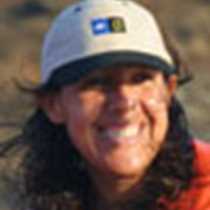Although we are currently experiencing the dry season in Galapagos, this morning the ship’s deck was wet when we awoke. Even there is not as much rain in the islands at this time of yet, it was clear that last night we had experienced some drizzle, known as garua, reminding us that the Galapagos always has a steady source of fresh water—only a gentle rain, almost unnoticeable, but good, clean water.
We disembarked at eight in the morning, and everybody was eager to start the day, because today we will be able to see, and learn about the Galapagos tortoises.
The landing area is Puerto Isidro Ayora, the most populated island in the Galapagos Archipelago, right after; all groups took different busses, just for a short ride to save time till the entrance of The Darwin Station, and National Park Service Headquarters. This morning we had a very pleasant temperature, so walking a mile and a half was easy, on a normal sidewalk, where we could observe the very green vegetation of Santa Cruz Island.
The landing area is Puerto Isidro Ayora, the most populated island in the Galapagos Archipelago. The temperatures this morning were very pleasant, so we enjoyed our walk from the landing dock to the National Park Service Headquarters for our tour. As we continued past the very green vegetation of Santa Cruz Island, we finally entered the Charles Darwin Research Station, and there they were: the tortoise corrals. The gigantic saddlebacks from Wolf Volcano had just started to become active, and they showed off their really long necks to us. Afterwards we met the small saddlebacks from Espanola—what a great difference in size between these two species. We continued on to have a look at the corral of the mixed species. The idea here is to notice the variety of shell shapes between the different strains of tortoise, depending on the island they come from.
The visit to the Charles Darwin Center also showed us the sad side of human impact on the islands, including the impact of introduced species into this archipelago—at the same time, we could see all of the efforts that have been made to solving these problems and protecting the islands. It was good for us all to see and understand this, and we left with a greater appreciation for the impact that we can have on the environment.
After our visit, we enjoyed some free time in the town of Santa Cruz before meeting up again at The Rock Cafe, a local bar, where we loaded our busses and headed up into the highlands for our next activity. Some members of the group opted instead to ride bikes along a road, enoying with lovely scenery on their way up to our next stop, El Traphice. This is sugar farm, established forty years ago, is owned by Adriano Cabrera, a very interesting old Galapagos settler who was willing to share with us his life experiences on the islands. Some of our guests visited a local school called Tomas de Berlanga—a project supported by Lindblad Expeditions. Education is an important part of conservation, inspiring others to appreciate and protect nature from an early age.
After our afternoon visit, we finally got together again for lunch at the a local restaurant called Aquelarre, located in the highlands of Santa Cruz. During lunch, we realized that it was drizzling again, which was excellent news—the rain is good for the vegetation, making the highlands green again, and providing food for the tortoises.
After lunch we had to finish the day with the best of the best—we finally went to see the tortoises in their natural habitat. We visited a protected area nearby where adult tortoises roam free, and we were able to approach them. Some were small, but many were very big, just the way we had imagined them. The highlands were still dry from the recent drought, which is normal in Galapagos, but the tortoises are used to difficult conditions, and they are very patient. The dry season of Galapagos, with its gentle rain, has begun.







